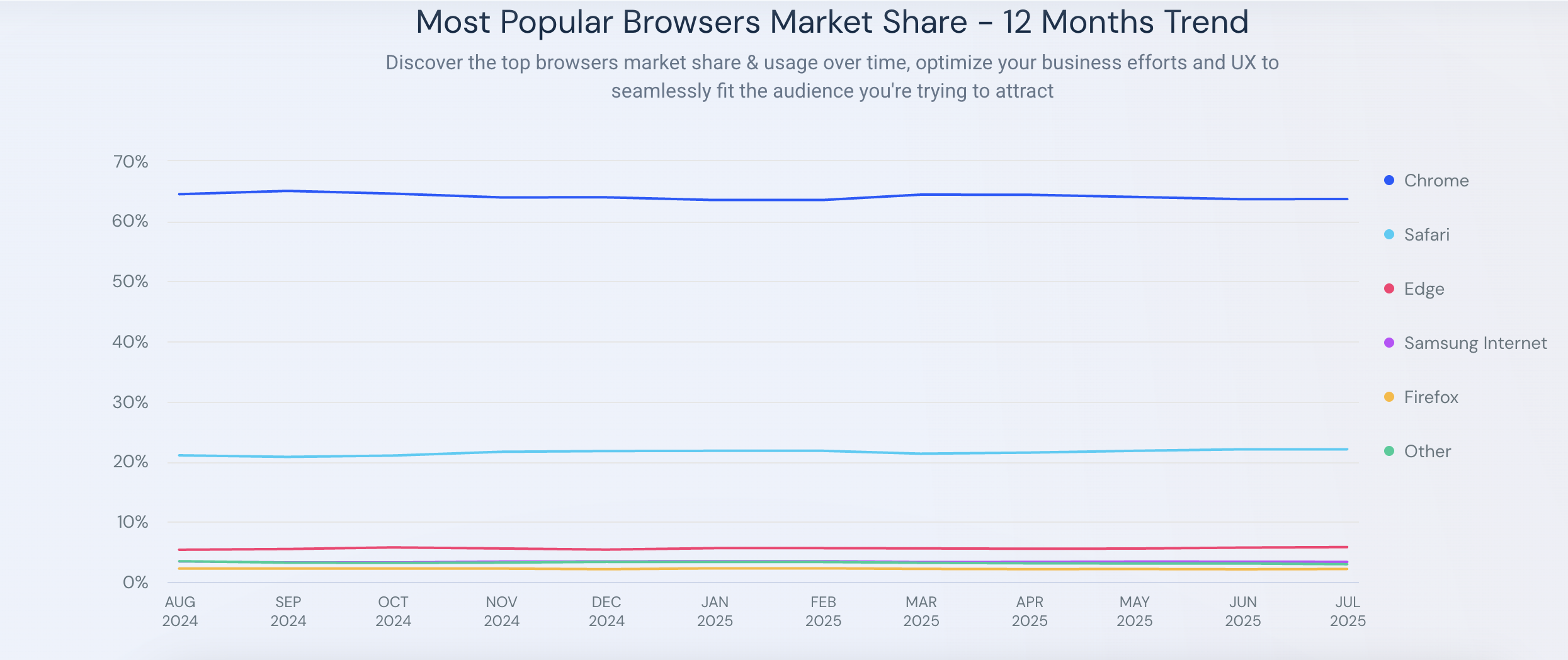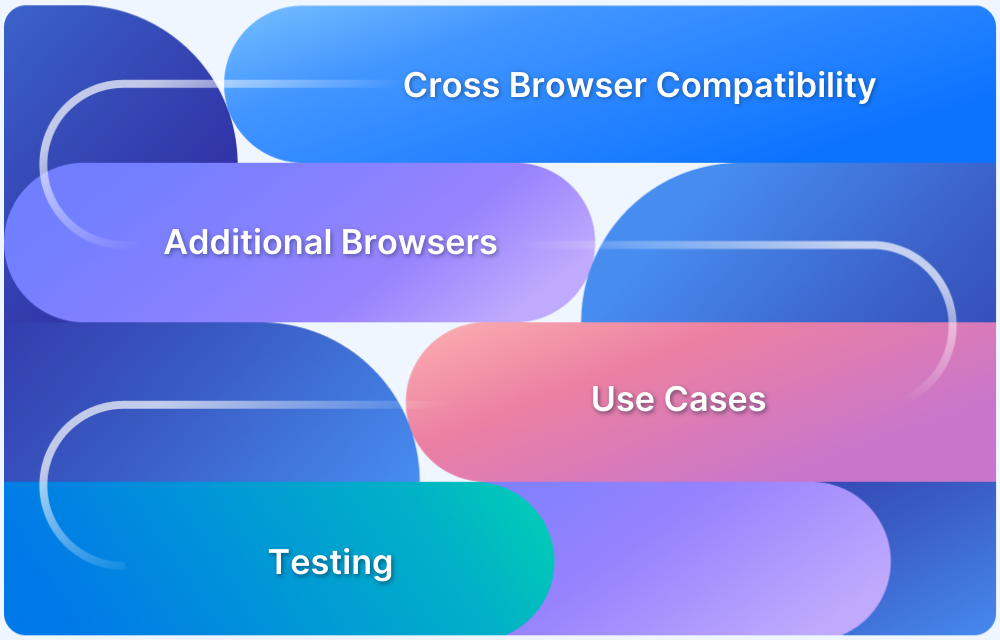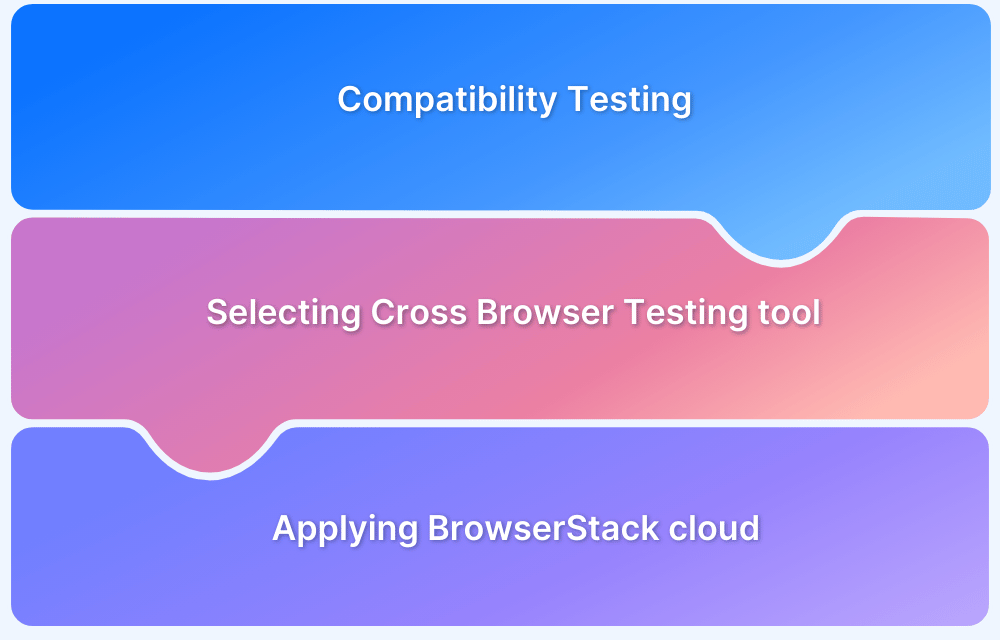Choosing the right browsers to test on is becoming increasingly complex as user preferences and market dynamics shift rapidly.
In 2025, understanding browser market share is crucial for QA teams to prioritize testing efforts, focus on the most widely used browsers, and ensure seamless user experiences across platforms.
Overview
Global Browser Market Share (Mid-2025)
- Google Chrome dominates with about 63.7% of the global market.
- Apple Safari holds second place with around 16%, driven by macOS and iOS users.
- Microsoft Edge follows with roughly 5–6% of usage.
- Samsung Internet and Firefox each capture about 2–3%.
- Opera maintains a small share in the low single digits.
- Other browsers, such as Brave, Yandex, and niche mobile-first browsers, collectively account for less than 1% each.
This article explores the latest browser market share trends in 2025 and highlights which browsers should be prioritized for effective testing.
The Browser Market As It Stands in 2025
Web browsers continue to advance at the same rapid pace as technology itself. With each year, vendors release new features, enhanced security measures, and performance improvements to meet evolving user expectations.
This constant innovation makes it challenging for businesses and QA teams to stay updated with the latest changes. Additionally, user preferences shift quickly as new browsers emerge and established ones evolve, making it essential to regularly reassess which browsers are most relevant for testing and delivering seamless digital experiences.
Overall Browser Market Share 2025
Source: similarweb
In 2025, Google Chrome continues to dominate the global market, followed by Apple Safari with strong adoption on Apple devices. Microsoft Edge secures the third spot, while Samsung Internet and Firefox hold modest shares.
Opera remains in the low single digits, and smaller browsers like Brave and Yandex collectively account for less than 1%. This mix highlights the importance of prioritizing major browsers while ensuring compatibility with niche ones.
Desktop-based Browser Market Share Stats 2025
On desktops, Google Chrome leads with nearly 65% share, followed by Microsoft Edge at around 13% and Apple Safari at 10%. Firefox holds close to 6%, while Opera and others remain in the low single digits.
Mobile-based Browser Market Share Stats 2025
In 2025, Chrome leads mobile browsing with over 61%, followed by Safari in second place and Samsung Internet in third. Smaller players like Opera and UC Browser hold minimal shares, making Chrome, Safari, and Samsung Internet the key priorities for mobile testing.
Individual Browser Statistics & Growth Pattern
Chrome continues to be the most widely used browser on both mobile and desktop platforms. Safari, benefiting significantly from being the default browser on iOS devices, holds a strong second place.
Google Chrome Statistics and Growth Pattern
- As of June 2025, Chrome is among the few apps on Google Play downloaded over 10 billion times.
- Other top Google apps in this category include Google Play Services, YouTube, Google Maps, Gmail, Speech Services by Google, Google Search, and Android Accessibility Suite.
- Chrome operates a Vulnerability Reward Program, offering up to $150,000 for discovering and reporting security vulnerabilities.
Mozilla Firefox Statistics and Growth Pattern
- The Firefox app on Google Play’s Android store has surpassed 100 million downloads.
- Firefox operates as a non-profit organization.
- Currently, more than 20% of Firefox users utilize the ‘Enhanced Tracking Protection’ feature, effectively blocking third-party tracking cookies.
Safari Statistics and Growth Pattern
- Safari is the #1 browser for US mobile users, commanding over 55.21% market share.
- Originally planned to be named ‘Freedom’ by Steve Jobs, developers advocated for ‘iBrowse.’
- Safari has steadily grown in the last decade, now holding a strong number 2 position in the browser market.
- By June 2025, Safari has achieved a usage share of 1-in-5 web users.
Edge Statistics and Growth Pattern
- The original Edge was HTML-based; in January 2020, Microsoft shifted to a Chromium-based version.
- The transition aimed to enhance compatibility and performance.
- Edge has seen consistent year-over-year growth, indicating growing user interest and adoption.
Samsung Internet Statistics and Growth Pattern
- Samsung Internet is a mobile device browser built on the open-source Chromium project and is widely available on many smartphones.
- Since 2015, Samsung Internet has garnered over 1 billion installations from the Google Play Store, surpassing combined installs of browsers like Firefox and Opera.
- Globally, Samsung Internet ranks as the 6th most popular browser across all platforms, following Chrome, Safari, Edge, Firefox, and Opera.
Here are the statistics and growth patterns for Google Chrome, Mozilla Firefox, Safari, Edge, and Samsung Internet as of 2025:
| Browser | Market Share | User Base | Key Growth Factors | Recent Updates | Global Reach |
|---|---|---|---|---|---|
| Google Chrome | 65-70% | Billions of users | Speed, security, extensive extensions, regular updates | Performance improvements, new features | Widely used on desktops and mobiles |
| Mozilla Firefox | 5-10% | Hundreds of millions | Privacy focus, open-source, customizability | Enhanced privacy tools, speed improvements | Strong presence in privacy-conscious regions |
| Safari | 15-20% (on iOS/macOS) | Hundreds of millions | Integration with Apple ecosystem, performance | Improved iCloud integration, privacy features | Primarily on Apple devices |
| Edge | 5-7% | Hundreds of millions | Integration with Windows, performance, security | New security features, performance boosts | Growing usage on Windows platforms |
| Samsung Internet | 2-4% | Millions of Users | Optimized for Samsung devices, privacy features | Enhanced privacy settings, speed improvements | Popular on Samsung mobile devices |
Should volume and market share be sufficient enough to decide the browsers to test on?
The short answer is No.
First, basing the decision only on volume would exclude a number of market-available browsers. The app’s target market must also be evaluated. For instance, millions of people continue to use Windows XP, and these users are likely to employ Internet Explorer. If the target audience uses Internet Explorer, the website must be fully functional on IE.
Business indicators and value addition may also play a significant role in determining the outcome of this choice. Safari is the second most popular browser, with the majority of its users operating it on Apple devices, which is indicative of affluence. Although having a lower user base than Chrome, these characteristics make Safari an important browser for testing.
Run Cross Browser Tests on Real Mobiles and Desktops
Moreover, with 62% of website traffic coming from mobile devices, it is apparent that users access websites via smartphones. Thus, testing websites on mobile browsers such as Samsung Internet is necessary to ensure mobile compatibility for a wider audience. Even standard browsers such as Chrome and Safari should be tested for mobile versions to guarantee that users can effortlessly access websites using these browsers.
Eventually, a mix of market share, value, and the type of the online application will assist users in narrowing down the browsers that an application or website must be compatible with.
Read More: All about Mobile Browser Automation
Why test websites on Real Browsers & Devices?
Testing websites on real browsers and devices is crucial to ensure a seamless and consistent user experience. Here are some reasons why prioritizing this approach is important:
- Precise Results: Testing on real devices and browsers provides accurate insights into how the website performs in real-world conditions, capturing details that emulators might miss.
- Thorough Testing: Each device and browser has unique behaviors and performance characteristics. Real device testing ensures all potential issues are identified across different environments.
- Enhanced User Experience: By testing on the same devices and browsers users use, issues that could frustrate them can be identified and addressed, thereby improving overall satisfaction.
- Effective Debugging: Real device testing allows for more accurate debugging, enabling quick identification and resolution of issues.
- Browser-Specific Bugs: Some bugs only manifest on specific browsers or versions. Real browser testing helps uncover and address these issues efficiently.
BrowserStack Live offers a robust platform that aligns perfectly with these needs:
- Immediate Access to Real Devices: Users gain instant access to thousands of real devices and browsers, facilitating real-time testing and debugging.
- No Setup Required: With BrowserStack Live, there’s no need for installation or setup. Users can simply log in and start testing on any device or browser right away.
- Reliable and Fast: Seamless testing sessions with minimal lag ensure efficient testing and rapid issue resolution.
- Secure and Private: BrowserStack ensures robust security measures, maintaining a safe testing environment for user data.
- Extensive Compatibility: Users can ensure websites function flawlessly across a wide range of device models, operating systems, and browser versions.
Choosing BrowserStack Live allows websites to deliver a flawless user experience across all devices and browsers, enhancing reliability and user satisfaction.
Conclusion
Given the discrepancy in the implementation of open web standards by different web browsers, cross-browser testing is required for web developers to achieve compatibility. It is the only approach to provide a uniform user experience across browsers and devices.
While Browser Market Share is a major consideration with which to choose which browsers to test on in 2025, other factors such as application-specific features, target audience, and geographical constraints must be considered to holistically ensure robust cross-browser testing.
Teams can begin cross browser compatibility testing manually with a real device cloud-based solution like BrowserStack Live or with automation tools like Selenium, which is trusted by the majority of enterprises in the automation testing industry.
Depending on the market share, it is essential to test on both the old and the most recent versions of different browsers. Perhaps most significantly, it is essential to test on actual devices, taking into consideration real user conditions for more reliable test results.
Using a cloud-based testing infrastructure such as BrowserStack to perform cross-browser testing is preferable than purchasing and maintaining a digital lab of actual devices.









